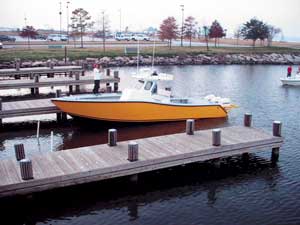
Clay Dyer has overcome incredible challenges, and competitors in bass-fishing tournaments no longer underestimate him.
I was just reminiscing with an old friend the other day. I remembered the first outboard boat that my father owned. It was a 15-foot tri-hull with a 33-horsepower Johnson hanging on the transom. Back then, that engine was considered large. A few years later, my dad opened his own outboard dealership, and we re-powered that boat with a 4-cylinder 65-horsepower Mercury. Boy, was that a step up!
My next engine was a 6-cylinder Mercury Mark 78, and later a 6-cylinder 100-horsepower Mercury.
I have had many engines since that time. It seems they have always been larger in both size and horsepower.
I guess my boating life has been a microcosm of the marine industry in general. Ever since the first outboards were introduced in the early part of the last century, engine manufacturers have been developing larger, heavier and more powerful engines.
Back in the old days, the first steering systems were rope and pulley. They consisted of a drum or cylinder under the dashboard that was attached to a steering wheel. The rope or cable was wound around the drum and then routed to the rear of the boat via a system of pulleys and tension springs. The cable was attached to the engine, and by turning the steering wheel, you could direct your engine wherever you wanted to go.
It wasn’t very long before the engine size and horsepower became too much for this system to handle, and something had to be done so that boat operators could have better control of these high-powered engines. Single-cable mechanical steering was developed, and remains the steering system of choice for many boaters today.
There have been improvements of this system over the years. The dual-cable mechanical steering has added much safety to some of the larger engines, and the most-recent innovation in mechanical steering, the No-Feedback system from Teleflex, offers even more safety and control for larger engines and boats.
As good as the mechanical system is, sometimes it is just not good enough. Steering manufacturers developed the hydraulic steering system. This system offered more power and control to the boater through the use of a hydraulic pump that is operated by turning the steering wheel and a hydraulic piston that is powerful enough to push the engine from side to side, overcoming the thrust created by these large engines.
For a long time, hydraulic steering was considered all that was needed, but as it has always done, the marine industry has continued to offer more horsepower, larger boats and heavier engines. We are now seeing boats rigged with two, three and even four of these horsepower monsters.
I recently had the privilege of water testing a 35-foot offshore fishing boat that my son Andy had just completed rigging for a customer. This boat is an all-aluminum deep-vee powered by three Evinrude E-tech 250-horsepower engines. That’s right, 750 horsepower of outboard motors hang off the transom of this boat.
Andy knew from the beginning that one of the most challenging aspects of this rig would be choosing the correct steering system. Fortunately for him, Teleflex Steering has a factory representative whose office is only a few blocks from our shop.
After inspecting the boat and engines, our friendly Teleflex representative suggested that we install the Teleflex Sea Star Pro Tournament Series. This hydraulic system was developed specially for the dual- and triple-engine installations.
He also encouraged us to install the Teleflex Sea Star Power Assist, which he claimed would be just like having power steering on your automobile. The Sea Star Power Assist is an electronically controlled hydraulic pump. It looks a lot like a hydraulic power trim pump on a Mercruiser Sterndrive. The power pump is used to boost the fluid that is sent from the helm to the cylinder.
The system virtually eliminates all steering load even in the most extreme application. The boat will be more comfortable to steer and can be driven safely and easily by almost any member of the family.
Andy rigged the boat using the systems recommended by Teleflex. When completed, we took the boat to the lake for a sea trial. Andy made the first couple of runs, and then he turned the helm over to me. I slipped all three Evinrudes into forward gear, and began to accelerate. The boat came on plane in a snap. I kept expecting to feel some sort of steering load or torque, but it never happened.
I took my time setting the trim angle for the engines, and then I chowed down on the throttles.
I was awed by the flawless handling of this 35-footer. The big monster with its 750-horsepower triple-engine package was actually easier to drive than my dad’s old tri-hull with the 33 Johnson.
With only the palm of my hand, I could roll the boat into a hard overturn, and again with only the palm of my hand recover from that hard overturn and throw the boat into a hard turn in the opposite direction. We actually had this big 35-foot boat doing figure 8s at almost full throttle.
If you have a large boat and are experiencing unacceptable levels of steering load, I would encourage you to investigate the Teleflex Sea Star Hydraulic Power Assisted Steering System. Talk to your local dealer; ask him to contact his marine supplier for the latest information on this system. You won’t believe the difference outboard power steering can be for your boating pleasure.
If you have any questions about this system or if there are any problems you may be having with your boat, you can contact me via e-mail at hanktheboatdr@yahoo.com. Have a happy and safe boating year.


